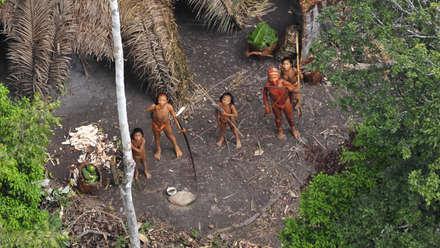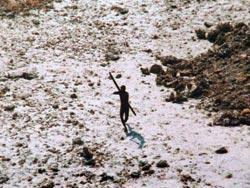Sunday Blogging - Tribe Sunday Blogging is about everything but Poetry. Recently I have been reading a lot about Tribes across the world and thought of sharing with you too and I have also written a poem inspired by Ishi – the last Native American in Northern Carolina
Imagine living on your own, in complete silence, always on the run, always fearful, invisible to the world. This is daily life for one solitary man in the Amazon. He’s the sole survivor of his tribe. We don’t know who he is, the name of his tribe or what language he speaks. His people were probably massacred by cattle ranchers who are invading the region at break neck speed. It’s eery walking through the tiny patch of forest where he lives. His presence is everywhere and one can sense him watching every move.His garden is brimming with produce – paw paw, manioc and corn. He will probably come under cover of night to gather the fruits when they are ripe. It must have taken him days to chop down the trees, single handed, to make the clearing. This is not an isolated incident. This is happening in every part of the world. In Australia is in the mission of eradicating its last tribes. America has successfully removed them from their own soil. Now we see the trend in developing countries. Oil workers and illegal loggers are invading the lands of uncontacted tribes in Peru. Channel like BBC has committed the mistake of trying to reach uncontacted tribe. A Blank on the Map (1971) is a BBC documentary written, produced, and presented by a young David Attenborough. It records an expedition to make first contact with a tribe of people who live in an area of Central New Guinea thought to be uninhabited. On the road to the tribe, David being David sheds light on the flora and animals which populate the jungles of Central New Guinea. You can watch/download the video here

http://www.uncontactedtribes.org/
As per Wikipedia Uncontacted peoples, also referred to asisolated peoplesorlost tribes, are communities who live, or have lived, either by choice (peoples living involuntary isolation) or by circumstance, without significant contact with globalisedcivilization Two tribes of theAndaman Islands, belonging toIndia, have sought to avoid contact with the outside world. It seemed inconceivable, above all, that the Sentinelese islanders could have survived, living as they did on a remote island directly in the tsunami’s path.

The photo that told the world the Sentinelese had survived the 2004 tsunami.
Yet when a helicopter flew low over the island, a Sentinelese man rushed out on to the beach, aiming his arrow at the pilot in a gesture that clearly said, ‘We don’t want you here’. Alone of the tens of millions of people affected by the disaster, the Sentinelese needed no help from anyone. Perhaps no people on Earth remain more genuinely isolated than the Sentinelese. They are thought to be directly descended from the first human populations to emerge from Africa, and have probably lived in the Andaman Islands for up to 60,000 years. The fact that their language is so different even from other Andaman islanders suggests that they have had little contact with other people for thousands of years. This does not mean, however, that they live just as they did 60,000 years ago. Commonly described, for instance, as belonging to the ‘Stone Age’, they do in fact make tools and weapons from metal, which they recover from ships wrecked on the island’s reefs.

The Sentinelese are believed to have lived on their island home for 60,000 years.
Like so many isolated tribal people with a fearsome reputation, the Sentinelese are often inaccurately described as ‘savage’ or ‘backward’. Their hostility to outsiders, though, is easily understandable, for the outside world has brought them little but violence and contempt. There are various other tribes in the world and we should not contact them and let them have thier own freedom. we have seen in the past how these people are not immune to modern diseases and most of them perished when they were contacted by the whites in Australia and America. The fight for more land and deforestation would continue and the struggle of these simple tribes across the world would continue. There would be many Ishi who would perish and would get lost in the flow of time. I will come back with more on this subject. Beast Inside is inspired by the Last Indian Ishi who appeared in North Carolina in the year 1911 Shamsud Source: /www.writerscafe.org If You Enjoyed This Post Please Take 5 Second to shareit.
